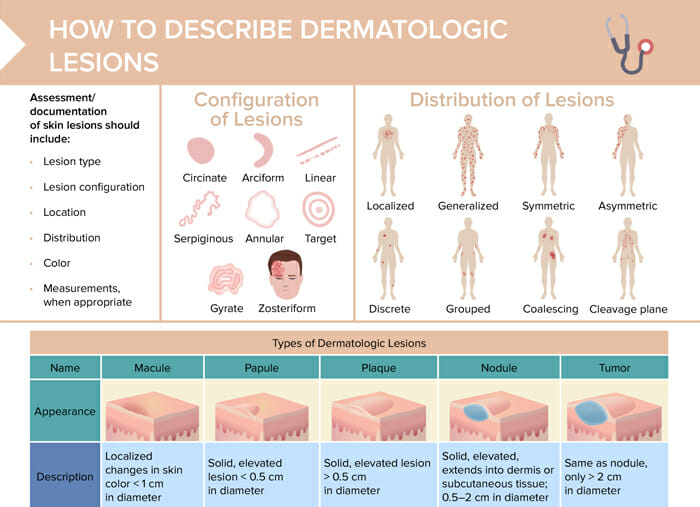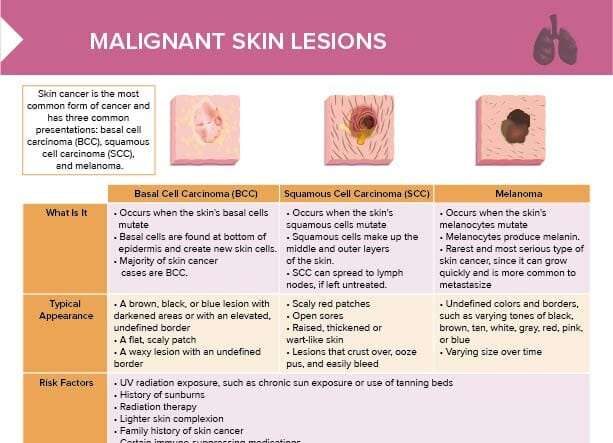What is skin cancer?
Skin cancer is the most common form of cancer and has three common presentations: basal cell carcinoma (BCC), squamous cell carcinoma (SCC), and melanoma.
Risk factors for skin cancer
Risk factors for developing skin cancer include:
- UV radiation exposure, such as chronic sun exposure or use of tanning beds
- History of sunburns
- Radiation therapy
- Lighter skin complexion
- Family history of skin cancer
- Certain immune-suppressing medications
- Certain genetic diseases
Note: Arsenic exposure is a risk factor for BCC and SCC, but not melanoma.
What is the ABCDE of melanoma/skin cancer?
The ABCDE of melanoma is a mnemonic used to help remember the key clinical features to look for when examining moles or other skin lesions for signs of melanoma. Each letter represents a characteristic that might indicate a mole is abnormal:
- A – Asymmetry: One half of the mole or skin lesion does not mirror the other half. Normal moles are generally symmetrical.
- B – Border: The borders of an early melanoma tend to be uneven. The edges may be scalloped, notched, or blurred.
- C – Color: Multiple colors or an uneven distribution of color can be a warning sign. This can include shades of brown, tan, black, red, blue, or white.
- D – Diameter: Melanomas usually have a diameter larger than the eraser of a pencil (6 mm or about 1/4 inch), but they may sometimes be smaller when first detected.
- E – Evolving: Look for moles or skin lesions that look different from the rest or are changing in size, shape, or color. Any change in a mole should be evaluated.
If a mole or lesion displays any of these ABCDE characteristics, it doesn’t automatically mean it’s cancerous, but it should be checked by a healthcare professional.
Types of skin cancer
Basal cell carcinoma
Basal cell carcinoma occurs when the skin’s basal cells mutate (found at the bottom of the epidermis, creating new skin cells). This is the most common form of skin cancer.
Basal cell carcinoma typically presents as a brown, black, or blue lesion with darkened areas or with an elevated, undefined border, a flat, scaly patch, or a waxy lesion with an undefined border.
Squamous cell carcinoma
Squamous cell carcinoma occurs when the skin’s squamous cells mutate (middle and outer layers of the skin). It can spread to lymph nodes, if left untreated.
Squamous cell carcinoma can present as scaly red patches, open sores, raised, thickened, or wart-like skin, or lesions that crust over, ooze pus, and bleed easily.
Melanoma
Melanoma occurs when the skin’s melanocytes mutate (the cells that produce melanin). It is the rarest and most serious type of skin cancer, since it can grow quickly and is more common to metastasize.
Melanoma can present as lesions with undefined colors and borders, such as varying tones of black, brown, tan, white, gray, red, pink, or blue. Its size varies over time.
How fast does skin cancer grow?
The different types of skin cancer have significantly varying growth rates.
Basal cell carcinoma typically grows slowly over months or years, rarely spreading to surrounding tissues. Squamous cell carcinoma typically grows over weeks or months, but can grow more rapidly in some cases. Melanoma has a variable growth rate, but is the most aggressive form and early detection is crucial to avoid spreading to other parts of the body.
Key nursing interventions for skin cancer
- Educating patients about
- Sun protection
- ABCDE assessment of lesions
- Encourage check ups
- Care around surgeries (if applicable)
- Obtain consent
- Medications
- Monitoring of surgical sites
- Symptom management (e.g. creams) and side effect management (e.g. of chemotherapy)
- Psychosocial support
- Care coordination (dermatology, oncology, plastic surgery)
Client education about skin cancer prevention
- Use of sunscreen with SPF > 30
- Long-sleeve clothing and other protective gear in sunlight
- Avoiding tanning beds
- Regular professional skin examinations, especially for higher-risk patients
- Follow up with all healthcare professionals as indicated if client has been diagnosed with malignant skin lesions before
- Performing self-examination of skin every few months
Can cancer cause itchy skin?
Yes, cancer can cause itchy skin (pruritus). Itching can be a symptom of certain types of cancer or can be related to cancer treatment.
Skin cancer lesions can be itchy, Hodgkin, Non-Hodgkin lymphomas and other cancers can present with itching, and cancer treatments like chemotherapy drugs can have itching as a side effect.

